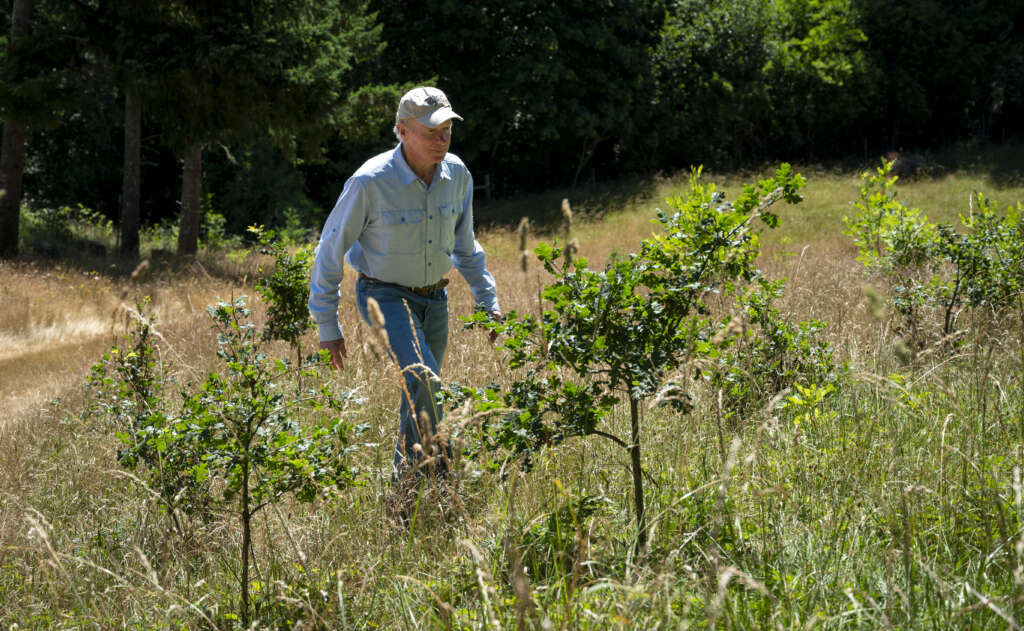Meet Jim and Maria Bradshaw, the King Estate vineyard partners behind our award-winning Bradshaw Pinot Noir wines. The Bradshaws are among more than 50 vineyard partners throughout the wine-grape growing regions of Oregon and Washington who supply about two-thirds of the fruit King Estate uses to make a surprisingly broad array of wines, from stalwarts like Pinot Noir and Pinot Gris, to popular Cabernet Sauvignon, to less well known varietals like Viognier and Gewürztraminer. Some partners are far flung and others, like the Bradshaws, are close to home, just a few miles up the road in Junction City. Whatever the distance or location, the key factor in choosing a vineyard partner is the relationship that develops with them. That’s as important as the vineyard’s soil, climate and terroir. In the case of the Kings and the Bradshaws, the relationship goes back more than three decades, when both families were just getting started in the wine business.
The beginnings of Bradshaw
For Jim and Maria, it began in 1988 with a tip from a friend from their hometown of Stockton, Calif., who worked in wine sales and advised Jim to keep an eye on Oregon. Jim had worked briefly in agriculture and liked the lifestyle. The idea of owning a vineyard had long been tickling the back of his mind. On his friend’s recommendation, Jim and Maria made their first trip to Oregon in 1988 and looked at a number of properties. When a realtor showed them a soil map for a property on Ferguson Road in Junction City that happened to have a 100-year-old grapevine growing on it, Jim and Maria knew that it would be good for growing grapes. The Bradshaws purchased the 100-acre property in 1989 and moved there in 1993 with their two young daughters. That first year they planted six rows of vines – two of Pinot Gris and four of Pinot Noir – on one acre of land. King Estate Vineyard Manager Meliton Martinez helped them plant using grapevines from King Estate’s nursery; Mel’s brother-in-law still works for the Bradshaws today.
Before becoming a vineyard, the site was home to a lumber mill (abandoned in the early 1900s), a hay-growing operation, and a schoolhouse. Like the Kings, the Bradshaws take their responsibility as stewards of the land seriously. In addition to launching their grape-growing operation, Jim and Maria undertook restoring a milelong riparian area along the banks of a stream that flows through the property and planting 15,000 native trees and shrubs to improve native habitat for cutthroat trout. A program to restore and expand acres of native oak savannah is ongoing.

Perfect pinot site in the Willamette Valley
The site is situated in the Willamette Valley just 35 miles east of Cape Perpetua on the Oregon Coast. At an elevation of 450 to 500 feet, the site has 42 acres planted mostly with Pinot Noir. The last significant planting was in 2010, although an acre of Chardonnay was planted in 2018 and an acre of Sauvignon Blanc in 2019. The vineyard produces about 100 tons of fruit a year, with 95% of it destined for King Estate wines.
A King Estate collaboration
As a cooler site, Bradshaw Vineyard, like King Estate, harvests a little later in the season, giving the grapes longer hang time for enhanced flavor development. COO/Winemaker Brent Stone says the fruit is always immaculate and boasts the excellent tannin and structure which makes for wines that are velvety and supple as they age. “The flavor profile tends toward bright fruit with strawberry, raspberry and cherry dominant most years,” Brent says. “The older blocks almost always score in the top 10% when we grade for quality.” Alcohol levels are usually on the lower end, he adds. “The wines generally show great balance between aromatic, flavor and tannin profiles.”
As hands-on owners, Jim and Maria often work seven days a week alongside a loyal, experienced team whom they credit for the end result. Every year after harvest, Jim will sit down with King Estate’s winemakers to taste through the lots, but he leaves blending decisions to them. “My thing is to take good care of the vines,” Jim says. “I know what makes a good environment to make grapes grow and to keep the vines healthy and balanced. That’s been our success.”
